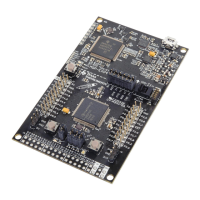22 Examples for TI-RTOS SPRUHU4D—February 2016
Submit Documentation Feedback
MSP430 MSP-EXP430FR5969LP Settings and Resources www.ti.com
Jumper settings:
•
Set RXD << and TXD >> to provide UART communications via the onboard USB debugger.
If you use a BoosterPack with this board (Section 3.8), the BoosterPack fits over J4 and J5.
SPI Loopback example pin connections:
The SPI loopback example is not supported on the MSP_EXP430FR5969LP.
Resources Used:
The following list shows which MSP_EXP430FR5969LP resources are used by TI-RTOS applications on
that platform. TI-RTOS examples control which peripherals (and which ports) are used.
•
TI-RTOS Kernel (SYS/BIOS). Uses the first general-purpose timer available and that timer's
associated interrupts. Generally, this will be Timer0_A3. The TI-RTOS Kernel manages the interrupt
controller statically without an interrupt dispatcher.
•
TI-RTOS.
— SD Card. Uses FatFs and the SDSPI driver on EUSCI_B0 without interrupts to read and write to
files.
—I
2
C. The I
2
C driver is configured on EUSCI_B0 to support various BoosterPacks.
—GPIOs. The GPIO driver is used on 2 onboard LEDs: LED1 (P4.6) and LED2 (P1.0) as output
pins and 2 switches S1 P4.5 and S2 P1.1 as inputs.
—Serial. The UART driver uses EUSCI_A0, which is attached to the onboard EZ-FET MSP430
USB chip to facilitate serial communications.
—SPI. The SPI driver is configured to use EUSCI_B0 for SPI communications. This instance
requires 2 DMA channels for the SPI transfer, one for transfer and one for receive.
— Watchdog. The Watchdog driver example uses Watchdog Timer A.
— WiFi. The WiFi examples for use with the CC3100 use GPIO pins P1.2, P3.0, and P4.2 as well
as the GPIO interrupt for port 1. In addition, it uses the EUSCI_B0 pins for SPI communications.

